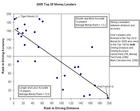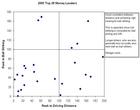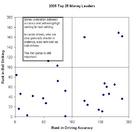Stopped taking Ambien? Well, I have just the organic cure for your sleep disorder.
But first, Commissioner, congratulations on the new 6-year deal. That's your 6-year deal at $4.5 million per year.
And now, the reason you get the big bucks. The floor is yours. Let's get the inevitable fifth major question out of the way:
Stature is something that we don't determine, others determine. At some point along the way in the '50s, stature meant calling The Masters a major. At someplace along the way earlier than that, the Western, which had been called a major, wasn't called a major anymore. Sometime around 1960 when Arnold Palmer wins at St. Andrews and the modern Grand Slam was sort of inaugurated, people sort of started talking about the British Open as a major, although it wasn't until the 1990s that we recognized the British Open as official money on this Tour and took steps to recognize it greater, even though it was clearly recognized as a major. So these things move around.
The British Open sort of was not a major until they sort of recognized it in the 1990s by sort of adding it to the money list. Take that Old Tom!
We were watching a film last [night] at the Past Champions Dinner about the shotmaking that these champions have conducted over the years, and I continue to believe that stature also has to do with people growing up watching things.
Whoa! A Champions Dinner. How original. What's next, azaleas, a champions locker room, a par-3 tournament?
And when a player like J.B. Holmes was 13 watching Freddie Couples make eagle at 16, and that generation grows up, I suspect that that will also impact on the stature of The Players. Where that leads, at least at this point, I'm not in a position to predict.
For those of us who can't remember one Players from another, I'm glad he mentioned how old J.B. was. The 1996 Players? Oh right...Freddie made eagle. I remember it like it was 1996.
Ah, now the fun begins.
Q. Is it your sense on TOUR that there's a feeling among players of helping rebuild the city's efforts by participating in this year's tournament (in New Orleans)?
TIM FINCHEM: There were two things we were focused on there. One was trying our best to be able to play when a lot of other sports, for whatever reasons, losing their stadiums, were not going to be in a position to play.
But then, secondly, we started to focus on the opportunity to tell a positive story through the tournament about the future of what's going to happen in New Orleans, and that's why we moved our Commissioner's Cup early in the week, which is the CEOs of 50 companies that do business with us, major companies, and we will do a half a day. We will do a half a day briefing is that right?
BOB COMBS: Yeah.
See, that's why Bob gets the big bucks.
TIM FINCHEM: I have to get up to speed.
Oops. Interrupted too soon.
We do a half day briefing with state and local folks so that these companies can understand the vibrancy of what's happening in New Orleans and what the upside is, instead of what we see in the newspaper all the time, whether the dam has really been fixed and isn't it a shame how the Federal Government bungled dealing with it. You don't really see the activity that's going on.
See, it's that liberal, Eastern media elite focusing on the negative. That's what's ruining America!
Oh, and not to be picky or anything Mr. Commissioner, but they were levees, not dams. Sorry, continue...
We want, through that briefing, and have Rudy Giuliani as our guest speaker for that, seminar if you will, to talk about what can happen. And then on the telecast that week, we will sort of tell that story. And so we want it to be an upbeat, positive message, and we're delighted to be able to participate in that.
Q. But do you feel a sense that the players by their participation feel that they can help rebuild or help the efforts of the City of New Orleans?
TIM FINCHEM: I think so. The quality of the event will also send the right message, too, that business as usual is returning to New Orleans. We're all worried about the tourism side of the equation in New Orleans, and not just the infrastructure getting rebuilt. That tourism needs to come back and be able to demonstrate we've got good quality golf facilities through the golf tournament, which is a big reason we have the tournament there anyways, is an important message as well.
See, it's really all about money telling that positive story.
Hey, time for a question similar to one suggested on this site:
Q. This course by modern Tour standards is not very long as Fred Funk proved last year, and this tournament has a history that you don't have to be a bomber to win here. Why hasn't this tournament followed the trend of extending courses to extreme length?
TIM FINCHEM: Well, I'd say the fundamental reason is that we recognize that the fans like watching this field play this golf course. To me that's the fundamental. And you have to be sensitive to that as you look at, you know, making this change or that change or where the ball is going or the fact now that we may have firmer, faster conditions. And so we have been we have been, I would say, knowledgeably and aggressively reticent, if you will, to make those kind of changes. That's the number one thing.
Knowledgeably and aggressively reticent. Wow, that could be the title of someone's biography!
The second thing is, I think we do like the notion that we have the deepest field in the game from A to Z, and virtually every one of those players can win. We would not want to move drastically away from that.
Craig Perks agrees.
Having said that, we have been looking at changes for a number of years, and we have made a few changes. I mean, we've moved a few tees over the years. But when we move a tee, we're not moving a tee because we're exasperated that a player is hitting a 7 iron versus a 5 iron.
Ouch, take that Hootie!
The other thing is that we don't want another answer to your question, frankly we're not excited about changes in the golf course being the story at any point in time. We want the golf course and the history of the golf course to be the story and not that myself or some group of people or some group of players got together and decided that it was a golf course that needed to be significantly changed. We don't see that.
Hootie, Hootie, Hootie. Even the Commish is saying you've gone too far and made it all about you. Wish I could be there when you two have your annual Masters stop and chat.
Q. The new schedule in 2007, have you given any thought to the introduction of a drug testing regime, and if not, why not?
TIM FINCHEM: Have I given any thought to?
Q. The introduction of a drug testing regime on the PGA TOUR, and if not, why not?
TIM FINCHEM: We have given a lot of thought to drugs.
Cialis, Levitra, Viagra. You know, potential tournament sponsors. Oops, sorry...
You can't not think about drugs with what is going on in today's sports. Our policies currently are if you're talking about steroids as an example, steroids are an illegal drug. I have authority of my board to require a test of any player who I have reason to believe or our team has reason to believe is using illegal steroids.
We are not opting for and by the way, I have no material information that that is the case with any player. We see no reason to jump into the testing arena at this point without having any credible information that we have issues.
In golf, a player is charged with following the rules. He can't kick his ball in the rough, and he can't take steroids. We rely on the players to call rules on themselves, and if you look at our Tour over the years, many players have, to their significant financial detriment. That's the culture of the sport.
Having said all of that, if, if, if we were to develop any basis upon which it was reasonable to assume that we had widespread steroid use or steroid use of any significance, we would not hesitate to engage, but it would not be a program that you and the public would look at and say, well, this is sort of a halfway program. It would be a program that would determine for sure that we did not have a problem.
If, if, if...speaking of if's, the Commissioner was asked about Fed Ex points...
I think that two things will happen. I think you will see some players play more in the base season. I think the players who have historically played in the fall will play in the fall. I think we'll see probably less European players in the fall because some of their bigger events are going to move back into the fall in Europe, and THE TOUR Championship isn't there to pull them back.
Other than that, I think the fall will probably be as good as it's been. There may be some more starts in that base season; I suspect there will be.
The fall has been so as "good as it's been," that it's being totally revamped and stuck behind the "base season."
Q. Can I just follow up on a very provincial question? Do I take it to understand that Washington is now in danger of not having a PGA TOUR event in 2007?
TIM FINCHEM: I wouldn't call it in danger. Every tournament has to have a sponsor, and we went through the period of talking to Booz Allen and we had very positive discussions with Booz Allen. We maintained a very solid relationship with them there and I think it was excellent of them to offer and commit, actually, to be a million dollar supporting sponsor.
Solid relationship? Can you imagine what the no-so-solid relationships are like?
Now we have to arrange for a title sponsor position. I have every reason to believe we will do that, but until it's done, it's not done.
Got that?
Until it's done, it's not done.
Actually, that was a special coded message to Bob Combs. Translation: these questions are veering coterminously toward a trajectory I find platform unfriendly.
BOB COMBS: Ladies and gentlemen, thank you very much.
TIM FINCHEM: Thank you.
No really, thank you.
















